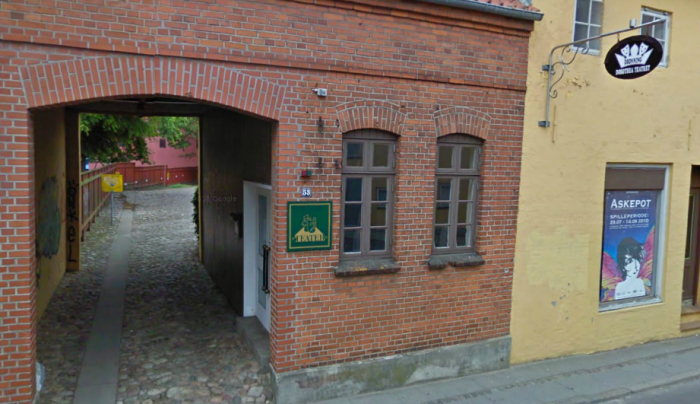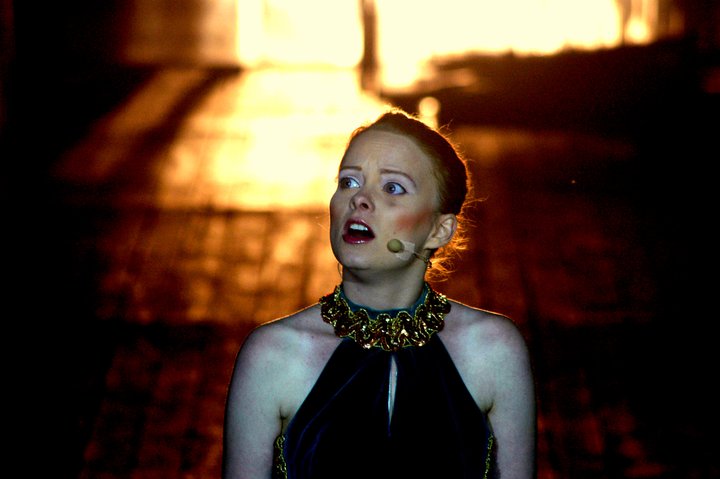
Queen Dorothea Theatre
The buildings located at the junction between the old approach road "Låsbygade" and Zahnsgade, therefore start orientation with Lasby Gades history.
Låsbygade
The first notice about Låsbygade is from 1484, when Sct. Canute guilds owned a farm in Låsbygade.
Låsbygade from the castle and the Hospital Street is one of Kolding's oldest streets. Until 1600 there was dirt road from Hospital Street, with the surrounding fields and grazing cows in the evening was driven home through the town to the stables. In about 1600 the Noerreport built. Outside Noerreport was Galgebakken and "Troldgruen" which was burning place for contemporary witches. There was then built houses between Hospital Street and Nørreport along the road and the fields behind the houses. There was established many guild houses and companion shelters in Låsbygade. Låsbygade has been the approach road to Kolding from the north, and thus one of Kolding's most important and significant streets.
Låsbygade the room has many merchant houses and also many pubs that serve the many farmers and traders who came to the street. In earlier times, Låsbygade a hard mud, with deep ruts. The street was closed "Mayor stone" which was used by street transition, ie by jumping from rock to rock. In Låsbygade were 3 rows "Mayor stone".
When Frederik 6 in 1832 was about Kolding demanded the police to Lasby Gades ruts were filled with gravel that there should bumped so hard when the king came running. In 1837-38 was Låsbygade paved.
In 1836 was built a hospital in Hospital Street, common to the city and the two counties. A doctor said: This hospital has hardly equaled by any of Jyllands Market towns. There were all five wards.
In the evening there were naturally dark and there was need for hand lamps. First in 1852 came oil lamps as street lighting. Because of the many kreaturpassager by road would be swept Wednesday and Saturday.
At the railway establishment in 1861, Låsbygade much considered as the site of Kolding Station. Part of the city's tycoons here among Consul Grau worked for the station should be located near Sct. Jørgen's Courtyard, with horse-drawn carriage for the harbor. As opposition to the location of the railway station in Låsbygade was at its peak, it was the supporters suggested that there was a connection between the port and the castle lake, with port calls at Koldinghus. However, it was the port location, there prevailed, although one also at that time was worried about the track adverse traffic impacts include when crossing Søndergade. Later Lasby Gades advocates placed a railway station at Nørreport the establishment of Egtved course.
"The old people home" at the end of Låsbygade was built in 1910th
Kolding's first kæmnerkontor was watchmaker shop in Låsbygade. Kæmnerhvervet was handled by watchmaker Jørgensen.
The tax rate was in 1900 at 5.30% and in 1910 as high as 9.7%.
Låsbygaarden
Construction The year is not known precisely, but has probably been in the 1600s. There have been registered many professions in the yard: Rope maker - Supermarket - Pub Holder - warehouse - stables. The first accurate records are from the Survey Protocol to the building tax from the 1802nd
1761-3 houses against Låsbygade
1781-1 house on Låsbygade supplied with 2 floors with timber
1791 - extension - existing meeting rooms and locker rooms
1835 - extension 1791 will have 2 levels
1847 - new warehouse built - the current theater - hoist for storage products
1867 - new side house is built - the current entrance room and bar
1980 - Kolding Municipality buy Borns farm for 750,000 kr. To a forced sale because the farm is included in the recovery plan for Consul Graus street area. The farm is divided into two ownerships with common owners association
1986 - Born's family wants the farm rebaptized Lasby farm, as it was originally named
Born's Garden - former Låsbygaarden
Named after Georg Herman Born, born in 1891 in Låsbygade 70, where his father had a shop and cigar factory.
Getting learn which hardware store was 15 years old.
Got early interest in newfangled airplanes.
Built his first airplane at merchant Grau in Låsbygade age 17.
Working at Ellehammer for 6 months. Without pay.
1912Handmade exhibition "Aerodynamic model-walking exhibition".
Did position as a pilot at a Copenhagen consortium without a certificate.
1913 1-year apprenticeship as cycling and armorer.
Military service as an aircraft mechanic.
1916 Incumbent electricity. electrician business in Vonsild.
Was married to Dorothea.
1923 Citizen Letter installer and grocery in Kolding Market town.
1929 Purchased Lasby farm, which then was called Born's farm. The wing facing Zahnsgade had business to houses. The expedition from the courtyard up a steep staircase. Current locker rooms were offices and handling. Behind offices was "the new stock", which is now a theater. Acted with everything within hardware, Hørkram and electricity. articles. Privaten lay out against Låsbygade. Distinguished private home with bath with claw feet.
Georg Herman Born was a Freemason - a small round man with cigar-stump in the corner of the mouth, always wore a beret and walking stick.
In the 60s, the business was sold and the buildings fell into disrepair and was used for various purposes.
In 1986, the theater building rented by Byfornyelsesselskabet.
On 1 January 2002, the theater building was bought by the association, there was the opportunity to establish workroom and kulisserum.
In recent years there has been played a very versatile repertoire at the little theater ranging from Kaj Munk to Dario Fo. We employ always professional instructors, while people of all other functions - with some exceptions - recruited among the members. Queen Dorothea Theatre has been a success, as we hopefully in years to come will be able to maintain and to expand.
Address
Zahnsgade 53
6000 Kolding
Contact info
Telefon: 75 53 30 50
Website
Queen Dorothea Theatre's website
http://www.facebook.com/pages/Dronning-Dorothea-Teatret/173554625997412




